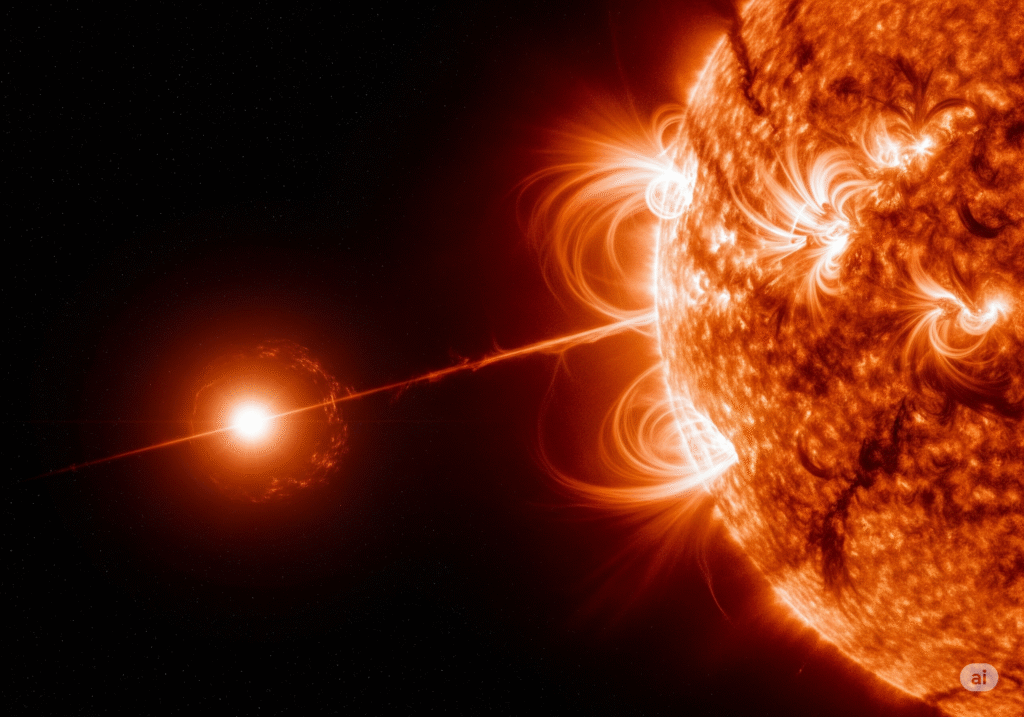Introduction: In September 1859, skies around the world erupted in brilliant colors as a massive solar flare slammed into Earth’s magnetic field. Telegraph systems caught fire, operators were shocked, and auroras glowed as far south as the Caribbean. This was the Carrington Event, the largest geomagnetic solar storm on record. Now, over 160 years later, our modern world—utterly dependent on electricity, satellites, and high-tech infrastructure—faces a sobering question: What if another Carrington-level solar superstorm hits us?
As we enter 2025, solar activity is ramping up toward a peak in its 11-year cycle. Scientists warn that the risk of a major solar storm is real and rising. Such an event could cause widespread power grid failures, communication blackouts, and economic chaos on a global scale. In this article, we’ll explore what a solar superstorm is, lessons from past solar incidents, how prepared (or not) we are as a society, and most importantly, what you can do to prepare for the day the sun decides to disrupt life as we know it.
[Illustration: The Sun ejecting a massive flare toward Earth, with Earth’s magnetic field visible; caption: “Artist’s concept of a solar superstorm heading toward Earth.”]What Is a Solar Superstorm (Carrington Event 101)?
A solar superstorm refers to an extreme form of space weather—essentially a massive outburst of solar energy and charged particles from the Sun that can wreak havoc on Earth’s magnetic field and tech infrastructure. The main culprits are:
- Solar Flares: Intense bursts of radiation from sunspots, traveling at the speed of light. These can cause immediate radio blackouts on the sunlit side of Earth.
- Coronal Mass Ejections (CMEs): Huge clouds of charged plasma hurled into space. If a CME is aimed at Earth, it can arrive in 1–3 days and jolt our magnetosphere, inducing strong electric currents in the ground and long conductors like power lines.
A solar superstorm usually involves both a strong flare and a fast, dense CME. The Carrington Event of 1859 was exactly that: a double-whammy that charged the atmosphere so intensely that telegraph networks (the high-tech of that era) went haywire. Operators reported sparks flying from equipment and some could even send messages with batteries disconnected, using the geomagnetically induced current instead!
Fast forward to today: our society is far more vulnerable. We have millions of miles of electrical wiring and pipelines, satellite constellations for GPS, communications and weather, and an internet that ties everything together. A Carrington-scale event hitting Earth now could knock out power grids by overloading transformers, disrupt global communications and navigation by frying satellites, and basically bring modern life to a standstill. Even a somewhat weaker storm, like the one in March 1989, caused a 12-hour blackout for the entire province of Quebec, Canada. And that was over 30 years ago, when we were less interconnected than today.
Key point: A solar superstorm is not science fiction or a “doomsday prophecy.” It’s a natural event that has happened before and will happen again—it’s a matter of when, not if. The Sun doesn’t follow human schedules or worries; it operates on its own cycle. Solar astronomers note that 2025 is expected to be the peak of the current solar cycle, meaning sunspot counts and solar flare frequency will be at a maximum. More solar activity raises the odds of Earth being in the crosshairs of a big one.
[Infographic: “Anatomy of a Solar Storm” – labeling a solar flare on the Sun, the CME cloud traveling to Earth, and effects like auroras and induced currents on Earth’s grid]Lessons from History: 1859, 1921, 1989 and Near Misses
To grasp the threat, let’s briefly look at history and recent near-misses:
- 1859 – The Carrington Event: The granddaddy of them all. Besides the dramatic auroras and telegraph fires, the Carrington storm’s intensity is estimated to have been twice as strong as the next largest recorded storm. If a similar event hit today, experts say it would likely cause widespread electrical disruptions and persistent blackouts for weeks or more. It’s hard to overstate: many transformers on power grids could burn out, and replacements could take months or years to produce, meaning prolonged outages.
- 1921 – The New York Railroad Storm: A powerful geomagnetic storm knocked out telegraph and railroad signaling in the U.S. It caused fires in telegraph equipment in several locations. Though less famous, it rivaled the Carrington Event in some measures. If 1921’s storm occurred now, the damage could also be enormous.
- March 1989 – Quebec Blackout: A CME struck Earth and collapsed Hydro-Québec’s grid within 90 seconds. Six million people lost power for at least 9–12 hours. This storm was significant but still much weaker than Carrington. It was a wake-up call that even a moderately severe space-weather event can do real damage. It also took out some satellites and disturbed satellites’ orbits.
- July 2012 – The Near Miss: Here’s a chilling fact many people don’t know: in 2012, a Carrington-class CME barely missed Earth. A NASA probe (Stereo-A) observed the solar eruption, and later analysis showed that had the CME occurred about one week earlier (when Earth was in that part of space), we would have been directly hit. Scientists believe it would have been on par with the 1859 storm. Talk about a close call! Our modern world was essentially spared by pure luck.
- Other recent activity: In late 2023 and early 2024, the Sun produced some strong flares and moderate geomagnetic storms that treated skywatchers to stunning auroras at unusually low latitudes. Notably, in May 2024, a storm dubbed the “Gannon Storm” (the strongest in about 20 years) struck Earth, causing satellite operators to scramble. Dozens of satellites had to perform emergency maneuvers (“mass migration”) to avoid damage. There were reports of short-lived power and radio outages in some areas as well. The Gannon Storm was a fraction of Carrington’s strength, yet it exposed gaps in our preparedness and satellite resilience.
The takeaway from history: Major solar storms have happened and will happen again. We’ve observed perhaps a half dozen significant ones in the past 170 years. The 2012 incident tells us the next “big one” nearly hit us already. So, the question isn’t fanciful; it’s a legitimate concern that scientists, governments, and power grid operators are actively discussing. In fact, a space-weather preparedness exercise in 2024 (run by NASA, FEMA, and other agencies) concluded that major weaknesses exist in how we’d handle a severe solar storm today. This exercise simulated multiple CMEs hitting Earth, and participants (from local and federal agencies) quickly found themselves overwhelmed by the cascading problems.
Are We Prepared? (Infrastructure & Society)
How ready are we as a society for a solar superstorm? In short, not very. Here are some concerns:
- Power Grid Vulnerability: Our electric grids are extensive, interconnected, and aging. Transformers – the workhorses of the grid – are particularly at risk. A powerful geomagnetic storm can induce currents that literally burn out these massive devices. The bad news: large transformers are custom-built, expensive, and not quickly replaced. Some experts fear that a Carrington-level event could blow dozens or hundreds of transformers, causing blackouts that last weeks or months in some regions. Efforts are underway to harden the grid and develop “geomagnetic storm blockers,” but progress is slow. An official U.S. government report bluntly stated that the US is not adequately prepared for a severe solar storm and that more coordination and equipment upgrades are needed.
- Satellites and GPS: Modern civilization leans on satellites for communication, navigation (imagine a week without GPS for planes, ships, and even your phone maps), banking transactions, weather forecasting, and more. Solar storms can knock out satellites or disrupt their electronics and orbits. During the 2024 Gannon Storm, dozens of satellites temporarily lost precise control and had to be moved, and some communication outages occurred. A Carrington Event could potentially disable a significant percentage of low-Earth orbit satellites. Think about the implications: military and emergency comms could be blinded, and everyday services like satellite internet or TV could vanish overnight.
- Communications and Internet: A big solar storm can induce currents not only in power lines but also long undersea cables that form the backbone of the internet. There’s concern that global internet traffic could be disrupted if key submarine cables’ repeaters get zapped. High-frequency radio communication is definitely affected (hams and mariners know this well), and even ground-based telecom could suffer if power is out and infrastructure is damaged. In 1859, telegraph was the only network—today we have telecom networks orders of magnitude more complex and sensitive.
- Supply Chains and Daily Life: Beyond the tech infrastructure, consider the ripple effects. If a large region’s power is out for weeks, the impacts go beyond no Netflix. Water treatment plants would struggle (many have backup generators, but fuel resupply could be an issue), gas pumps don’t work (no electricity), hospitals run on generators and might run low on fuel, food supply chains falter (refrigeration, transport, payment systems all affected). Society as a whole would be severely tested. A NASA analysis noted that such “technological chaos” from a Carrington-like event could cripple economies and endanger lives worldwide.
- Government & Agency Preparedness: Agencies like NASA, NOAA, and FEMA have been paying more attention to space weather in recent years. NOAA’s Space Weather Prediction Center now provides alerts for solar storms. NASA has satellites (SOHO, DSCOVR, SDO, Parker Solar Probe, etc.) monitoring the Sun. There’s even new AI models being tested to predict geomagnetic storm impacts with about 30 minutes warning. However, a warning is only useful if actionable. The 2024 exercise revealed that clear protocols for utilities and the public are lacking. The exercise recommended developing communication templates similar to hurricane warnings. In other words, we need a sort of “solar storm emergency plan” at national and local levels, which is still in infancy.
To sum up: We’ve made some strides (improved forecasting, small-scale drills, more awareness in the scientific community), but critical infrastructure is still quite exposed. The phrase “lottery odds” is often used—meaning a mega-storm is not likely on any given day, but over a span of decades, the chance is significant. Considering the potential devastation, many experts feel it’s an under-addressed risk. And unlike some disasters, we can’t prevent a solar storm; we can only prepare for it.
How to Prepare Personally for a Solar Superstorm
While utility companies and governments debate big fixes, individual preppers want to know: What can I do to get ready for a solar-induced grid-down scenario? Fortunately, preparing for a solar superstorm is very much like preparing for any long-term power outage or infrastructure failure. Here are some steps:
- Build a Robust Emergency Kit: Ensure you have ample supplies of food and water at home. Aim for at least 2 weeks’ worth of non-perishable food for your family, and 1–2 gallons of water per person per day (plus water filters/treatment methods). A solar storm could create a blackout and disrupt supply lines, so longer-term supplies (1-3 months) wouldn’t hurt if feasible. Don’t forget essentials like medications, first aid, and sanitation items.
- Backup Power and Lighting: Since a solar superstorm could knock out power for extended periods, invest in alternative power sources. Options include:
- Portable Generators: Good for short-term use to keep the fridge cold and lights on. Store enough fuel safely, and have a way to ventilate exhaust. Note that fuel resupply might be hard if pumps are down.
- Solar Panels & Battery Banks: Ironically, the Sun might cause the problem, but solar panels can be part of the solution for individual homes. A basic off-grid solar battery system can charge phones, run radios, and even power small appliances if sized right. Just be sure to have charge controllers to prevent power surges.
- Power Stations: These are high-capacity battery packs (like Jackery or Goal Zero) that can be charged via solar panels or your car. They’re great for silent, indoor power for electronics.
- Low-tech lighting: Stock up on flashlights, lanterns (LED or propane), and lots of batteries. Crank-powered or solar-charging flashlights and lanterns are excellent since they don’t rely on grid power at all.
- Communication Gear: If the internet and cell networks go down, how will you get information? Every prepper should have a battery or hand-crank NOAA weather radio (which also picks up emergency broadcast stations). These can provide crucial updates. Even better, consider getting a HAM radio license or at least a basic HAM receiver/scanner to monitor amateur radio — HAM operators often provide info during disasters. Two-way radios (walkie-talkies) can keep you in touch with family or neighbors locally. Keep all these electronics in a simple Faraday cage or bag when not in use, to protect against any induced currents (there is debate on whether that’s necessary for a solar storm, but for small devices it’s easy protection).
- Protect Electronics: While a solar storm is not exactly an EMP, it can cause power surges. Use surge protectors on important devices. Unplug electronics if a severe solar storm warning is issued (especially during the peak hours of the geomagnetic impact). If you have spare critical electronics (old phones, radios, backup hard drive with important data), storing them in a grounded metal ammo can or Faraday bag isn’t a bad idea.
- Plan for Water & Sanitation: If power is out, city water might stop flowing (no pumps) and sewage systems could back up. Store water and have a plan for collecting and filtering water (rain barrels, nearby lake/stream + filters). Also have a portable toilet solution or buckets, garbage bags and bleach for sanitation if plumbing is offline.
- Heating/Cooling: A major concern if the grid is down in extreme weather. For winter, have backup heat that doesn’t rely on electricity (wood stove, kerosene heater – be mindful of ventilation and safety). For summer, stock up on ways to stay cool: battery fans, cool packs, and knowledge of how to stay hydrated and avoid heat stroke.
- Transportation and Fuel: Keep your vehicles gas tank at least half full at all times if possible. Gas pumps won’t work without power. If you have a generator, store fuel (with stabilizer) safely. Bicycles can be invaluable if gas becomes scarce. If you rely on an electric vehicle, think about how you’d charge it off-grid or have alternative transport.
- Community and Security: In a prolonged crisis, community cooperation is huge. Get to know neighbors; maybe quietly gauge if they’re open to teamwork in emergencies. Community preparedness can fill gaps (one neighbor has a well, another has a generator, etc.). Unfortunately, prolonged blackouts can also lead to opportunistic crime or unrest. Without stoking fear, it’s wise to consider home security. That could mean as simple as solid locks and outdoor solar lighting—or if you’re comfortable and trained, firearms for self-defense. Every family’s approach will differ, but don’t leave the topic unaddressed.
- Use Tools and Guides: Make use of planning tools like the [Link: OmniPrepper Threat Planner] to map out your specific action plan for a grid-down event. An emergency plan for your family is crucial: if separated when it hits (say, at work or school), how will you regroup, where, and what steps should each person take? Write it down and make sure everyone knows the basics.
Personal readiness for a solar superstorm is largely about being able to live without the grid and modern tech for a while. It sounds daunting, but if you’re a prepper, you’re probably already preparing for similar outcomes (hurricanes, EMPs, cyberattacks, etc.). Solar superstorm prepping is just ensuring those same supplies and skills are in place.
One more thing: stay informed. The good news is we likely would get some warning. If a huge CME erupts, spacecraft will detect it and we might have anywhere from 18 hours to several days notice. You should be ready to take last-minute actions if a warning comes: top off water containers, fuel up vehicles, unplug electronics, etc. NOAA and NASA alerts can be received via apps or radios. So include in your plan how you’d respond if a solar storm alert goes out.
Silver Linings? (Finding Optimism)
It’s easy to paint an apocalyptic picture with this topic. But there are a few positives:
- Aurora Spectacle: If a big geomagnetic storm hits, even as we cope with issues, we might witness the most breathtaking auroras in a lifetime, shimmering far beyond their usual polar ranges. (Small comfort, but it’s something awe-inspiring amid the chaos.)
- Resilience is Being Built: The very fact we’re talking about this means people are working on it. Governments are slowly installing early-warning systems. Power companies in some regions are studying how to isolate parts of the grid to limit damage. New satellites are planned to improve forecasting. It’s not all ignorance and inaction.
- Preppers Have an Edge: If you’re reading this on OmniPrepper, chances are you already have a preparedness mindset. That puts you miles ahead of the average person in handling a black-swan event like a solar superstorm. While others may be panicking or scrambling, you’ll be ready to keep a cool head, help your family, and maybe even assist neighbors. Sometimes our loved ones ask, “Why do you spend energy on prepping?” A solar superstorm scenario is one big answer why.
Conclusion: Eyes on the Sky, Feet on the Ground
The 2025 solar superstorm threat encapsulates why preparedness isn’t just for fringe scenarios—it’s for real, if rare, events that could fundamentally challenge our way of life. Are we ready for another Carrington Event? As a society, not yet. But individually, we can take steps to ensure our families can weather the solar tempest.
In summary, stay informed about space weather during these active solar years. Take concrete actions to harden your home and routine against a long power outage. Mentally walk through a scenario of “no power or internet for a month” and plan how you’d cope. Use resources like [Link: OmniPrepper Grid-Down Guide] or [Link: OmniPrepper Faraday Cage Tutorial] for specialized tips. Preparing for this kind of event covers a lot of bases—once you’re set for a solar megastorm, you’re naturally prepared for a host of other disasters too.
We can’t stop the Sun from doing what it does. But we can be ready, just in case our star gives us a truly tumultuous gift in the coming months or years. As the proverb says, “Hope for the best, prepare for the worst.” Enjoy the sunshine, but keep one eye on those space weather reports!
For more guides on protecting your home, family, and technology from the unexpected, visit OmniPrepper.com. Our mission is to empower you with knowledge and tools so that when the next solar flare—or any crisis—strikes, you won’t be in the dark. Stay safe, stay prepared!




